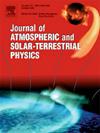关于长期太阳活动可预测性的进一步证据:使用新数据重建的测试
IF 1.9
4区 地球科学
Q3 GEOCHEMISTRY & GEOPHYSICS
Journal of Atmospheric and Solar-Terrestrial Physics
Pub Date : 2025-05-20
DOI:10.1016/j.jastp.2025.106541
引用次数: 0
摘要
人们已经认识到,放射性核素可以用来重建长期的太阳活动。最近,从公元前6755年到19世纪晚期,有了新的重建。这可以与实际的太阳黑子数据拼接在一起,以年代际分辨率创建一个连续的太阳黑子序列。虽然极小期和极大期的时间与先前的估计相当,但新的重建表明太阳活动总体较高,趋势较小。预测实验在10-80年的范围内运行,使用回归,回归和神经网络的组合,以及支持向量机。尽管新的和以前的重建之间存在差异,但研究结果与早期的研究基本相同。太阳的长期变化不表现出规律的周期性。虽然可以使用频谱分析来识别周期,但这些周期不能在时域中得到确认。自相关函数和滞后的回归显示在较低频率下没有周期的证据。在这里进行的实验中,这些模型通常能很好地预测30年后的情况。40年后,预测精度开始下降。在50-80年的范围内,这些模型要么收敛于数据的平均值,要么以滞后的方式复制最近的波动。根据研究结果,太阳活动本质上是随机的,无法通过时间序列或人工智能模型预测几十年后的情况。本文章由计算机程序翻译,如有差异,请以英文原文为准。
Further evidence on the predictability of long-term solar activity: Tests using new data reconstructions
It has been understood for some time that radionuclides can be used to reconstruct long-term solar activity. Recently, new reconstructions have become available, spanning the interval from 6755 BC to the late nineteenth century. This can be spliced together with actual sunspot data to create a continuous series for sunspots at a decadal resolution. While the timing of minima and maxima are comparable to prior estimates, the new reconstruction implies higher overall solar activity and less trending. Forecasting experiments are run over horizons of 10–80 years using regressions, combinations of regressions and neural networks, and support vector machines. Despite the differences between the new and prior reconstructions, the findings are essentially the same as in earlier studies. Long-term solar variations do not exhibit regular periodicities. While cycles can be identified using spectral analysis, these are not confirmed in the time domain. The autocorrelation function and regressions on lags show no evidence of cycles at lower frequencies. In the experiments run here, the models generally predict well up to 30 years. At 40 years, forecast accuracy begins to deteriorate. At horizons of 50–80 years, the models either converge to the mean of the data or replicate recent fluctuations with a lag. Based on the results, solar activity is essentially stochastic and cannot be predicted by time series or artificial intelligence models beyond horizons of a few decades.
求助全文
通过发布文献求助,成功后即可免费获取论文全文。
去求助
来源期刊

Journal of Atmospheric and Solar-Terrestrial Physics
地学-地球化学与地球物理
CiteScore
4.10
自引率
5.30%
发文量
95
审稿时长
6 months
期刊介绍:
The Journal of Atmospheric and Solar-Terrestrial Physics (JASTP) is an international journal concerned with the inter-disciplinary science of the Earth''s atmospheric and space environment, especially the highly varied and highly variable physical phenomena that occur in this natural laboratory and the processes that couple them.
The journal covers the physical processes operating in the troposphere, stratosphere, mesosphere, thermosphere, ionosphere, magnetosphere, the Sun, interplanetary medium, and heliosphere. Phenomena occurring in other "spheres", solar influences on climate, and supporting laboratory measurements are also considered. The journal deals especially with the coupling between the different regions.
Solar flares, coronal mass ejections, and other energetic events on the Sun create interesting and important perturbations in the near-Earth space environment. The physics of such "space weather" is central to the Journal of Atmospheric and Solar-Terrestrial Physics and the journal welcomes papers that lead in the direction of a predictive understanding of the coupled system. Regarding the upper atmosphere, the subjects of aeronomy, geomagnetism and geoelectricity, auroral phenomena, radio wave propagation, and plasma instabilities, are examples within the broad field of solar-terrestrial physics which emphasise the energy exchange between the solar wind, the magnetospheric and ionospheric plasmas, and the neutral gas. In the lower atmosphere, topics covered range from mesoscale to global scale dynamics, to atmospheric electricity, lightning and its effects, and to anthropogenic changes.
 求助内容:
求助内容: 应助结果提醒方式:
应助结果提醒方式:


